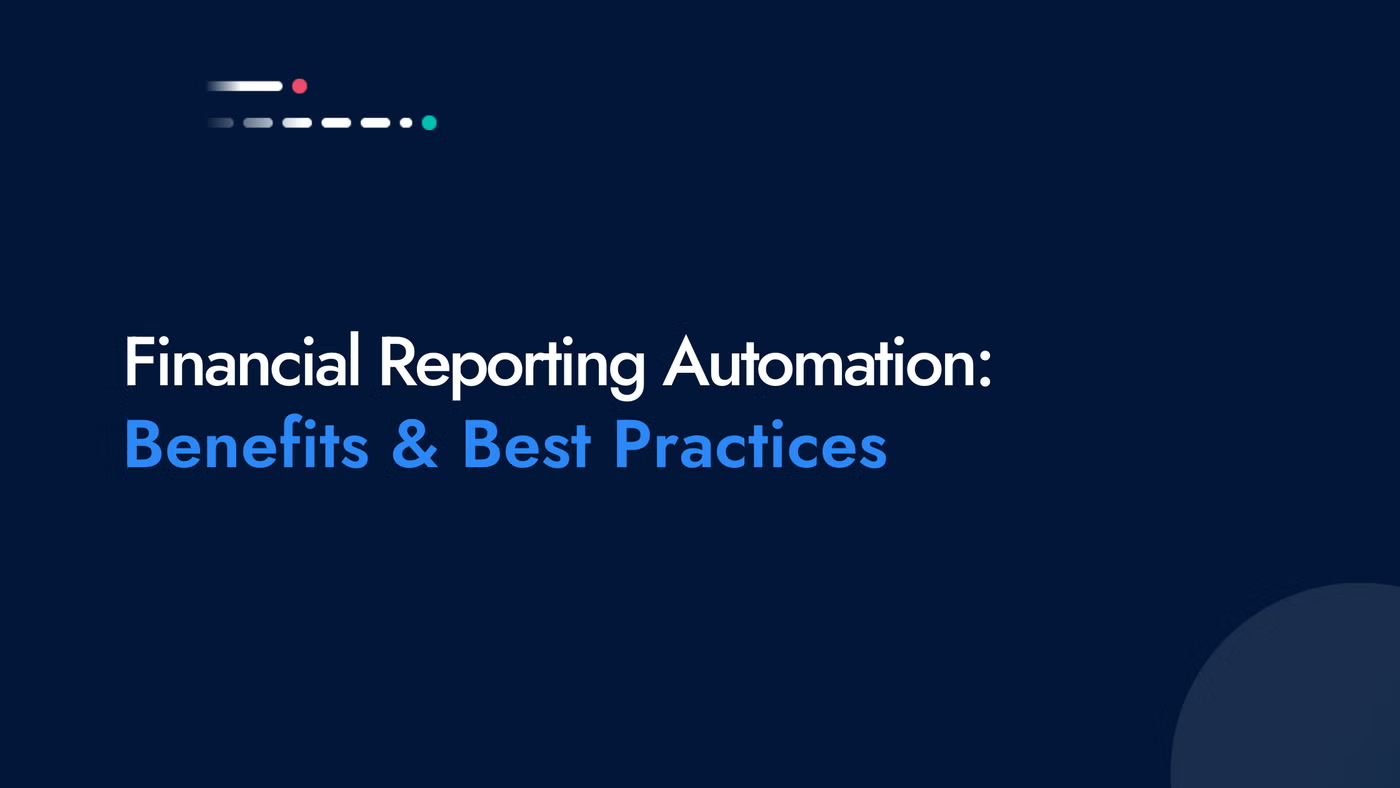- /
- Blog
Financial Reporting Automation: Benefits & Best Practices

🎓 Introduction to Financial Reporting Automation
Depending on the size and complexity of the organization, financial reporting usually requires its own team, which can be quite costly for large companies.
But the cost of financial reporting extends well beyond the financial reporting team, as the reporting tasks involve collaboration with many different departments within an organization, including legal, compliance, IT, sales, marketing, and other operational areas.
Often, many of the financial reporting tasks are outsourced to accounting firms and outside counsel, coming at a substantial cost.
Financial reporting automation utilizes technology to reduce the manual processes involved in this key control. Automating the process can expedite the collection of relevant financial data and information.
It can standardize the recording of transactions and journal entries. It can aid in the maintenance of the general ledger and result in fewer errors in the trial balance. Automation can ensure an efficient and accurate exception and approval process.
It is a process ripe for automation, involving a myriad of routine processes that need to be completed within tight timeframes that are often mandated by internal requirements or external regulations.
Because of the routine nature of financial reporting, and its importance to the company’s reputation, financial reporting is an attractive target for automation.
✅ Benefits of Financial Reporting Automation
- Time and cost savings: Automation saves time and reduces the effort required for collecting, processing, and analyzing financial data. This frees up the finance team to concentrate on more valuable tasks. It also cuts costs by optimizing resource allocation and minimizing manual data entry.
- Increased accuracy and fewer errors: Automation minimizes the chances of human error in manual processes. By standardizing data entry, automating calculations, and ensuring data consistency, it improves accuracy and reduces errors. This leads to more reliable financial reports and better overall data quality.
- Automation streamlines data management and consolidation, making it easier to access and analyze financial data. Real-time visibility into financial information enables stakeholders to make informed decisions quickly and respond promptly to market changes.
- Enhanced compliance and risk reduction: Automation helps organizations comply with regulatory requirements and internal controls. Automating compliance checks, validation processes, and audit trails, reduces the risk of non-compliance and errors that could result in financial penalties or harm the organization's reputation.
- Scalability and flexibility: Financial reporting automation can scale and adapt to organizational growth or changes. Automated systems efficiently handle increasing data volumes, new reporting requirements, and changes in business structures, unlike manual processes.
- Faster reporting and decision-making: Automation speeds up the financial reporting cycle, enabling quicker and more timely reporting. Real-time data processing and automated report generation reduce the reporting turnaround time, allowing stakeholders to access critical financial information promptly. This facilitates faster decision-making and supports agile business operations.
By implementing automation effectively, organizations can minimize errors and enhance data accuracy, leading to improved error tracking overall. Automation also frees up time for experts to focus on evaluation and decision-making based on reliable, validated data.
🤖 Best Practices for Implementing Financial Reporting Automation
- Time and cost savings: Automation saves time and reduces the effort required for collecting, processing, and analyzing financial data. This frees up the finance team to concentrate on more valuable tasks. It also cuts costs by optimizing resource allocation and minimizing manual data entry.
- Increased accuracy and fewer errors: Automation minimizes the chances of human error in manual processes. By standardizing data entry, automating calculations, and ensuring data consistency, it improves accuracy and reduces errors. This leads to more reliable financial reports and better overall data quality.
- Improved data visibility and accessibility: Automation streamlines data management and consolidation, making it easier to access and analyze financial data. Real-time visibility into financial information enables stakeholders to make informed decisions quickly and respond promptly to market changes.
- Enhanced compliance and risk reduction: Automation helps organizations comply with regulatory requirements and internal controls. Automating compliance checks, validation processes, and audit trails, reduces the risk of non-compliance and errors that could result in financial penalties or harm the organization's reputation.
- Scalability and flexibility: Financial reporting automation can scale and adapt to organizational growth or changes. Automated systems efficiently handle increasing data volumes, new reporting requirements, and changes in business structures, unlike manual processes.
- Faster reporting and decision-making: Automation speeds up the financial reporting cycle, enabling quicker and more timely reporting. Real-time data processing and automated report generation reduce the reporting turnaround time, allowing stakeholders to access critical financial information promptly. This facilitates faster decision-making and supports agile business operations.
DataSnipper’s Financial Reporting Automation Solution
DataSnipper offers the next generation of ‘tick and tie’ with the add-on module, the Financial Statement Suite.
